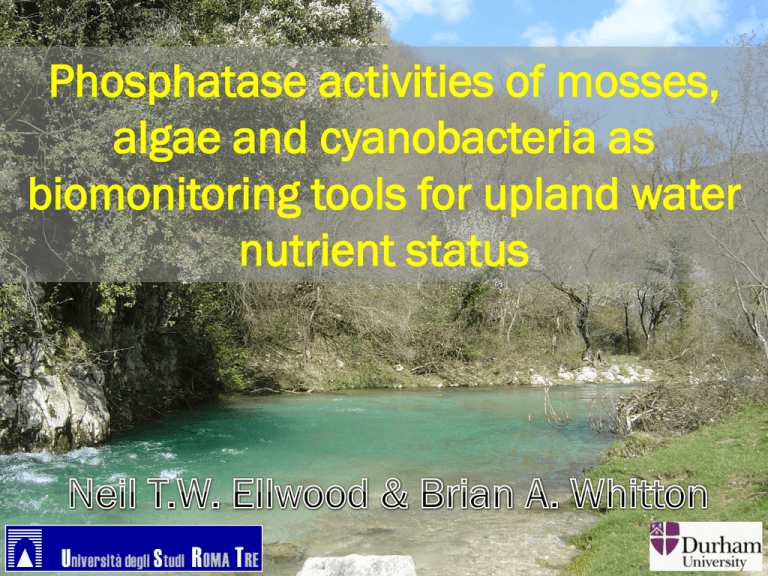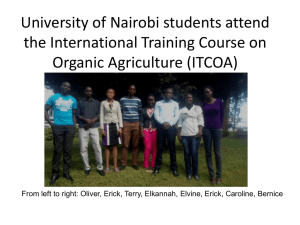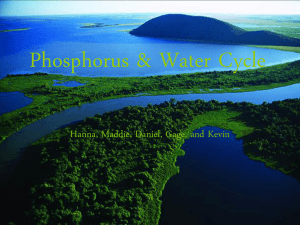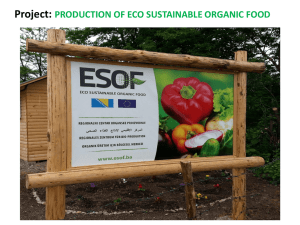EllwoodWhitton_Phosphatase_Activities_of_Mosses
advertisement

Phosphatase activities of mosses, algae and cyanobacteria as biomonitoring tools for upland water nutrient status Water Framework Directive and uplands The WFD derived from gaps in previous legislation to protect Europe’s water. Two key requirements: • To classify ecological status and, where necessary, restore the structure and function of aquatic ecosystems. • Introduction of a river basin management planning system. • Biological classification systems have been intercalibrated at EU level for comparability between member states. • Present biomonitoring methods can contribute to ecological status classification and the restoration but mainly for lowland rivers with high inorganic nutrient loads. • Planned management measures (basic measures) have been set out to tackle pollution problems • In upland areas however, ‘basic measures’ are mostly not applicable and so ‘supplementary measures’ need developing. • Classification using standard monitoring methods of water chemistry can be misleading. • The implementation of the diatom methodology for the WFD is suited for more downstream sites (useful for inorganic nutrients, less environment variation). • Need to develop a new biomonitoring system for uplands Biological monitoring and upland streams • The large surface area of upland catchments and the associated meteorological conditions and exposure to climate warming and atmospheric N deposition all result in a highly vairable and shifting stream water quality. • Another confounding feature of upland areas is that much of the filtrable nutrient fractions/species in flowing waters can be organic, deriving from organic rich soils (e.g. peat, forested soils). • At present the ‘basic measures’ of biological classification under the WFD does not take organic P into consideration. • Ideal organisms for this purpose should be widespread and tolerant of a range of nutrient levels, as opposed to species with narrow ecological ranges. • Organisms should "integrate" the environment over much longer period, such as longlived algal colonies and, ideally, also aquatic bryophytes. Bioavailability of organic phosphorus • Most, if not all, phototrophs can utilize inorganic phosphate in their environment, and it is commonly assumed that the ability to utilize organic phosphate is more restricted. • Yet there is a very large and increasing body of evidence proving that many organisms can use organic compounds as a P source. • And it has also been shown that organisms can utilize organic phosphates as their sole phosphorus source, much of the evidence has come indirectly from studies on phosphatases and phosphatase activity…. • ….and research has shown that many organisms from upland regions have high surface phosphatase activity and, where tested, can grow on organic P sources, so organic P is clearly important. • Surveys of species distributions and water chemistry have shown that some organisms are actually favoured by organic P. S h oot L en gth (m m ) Growth of organisms using organic phosphorus 0.25 mg L-1 P 90 0.5 mg L-1 P 1 mg L-1 P 60 30 -2 B iofilm D W (m g cm ) Growth of the aquatic moss Warnstorfia fluitans (Hedw.) Loeske from an acidic stream in North-East England in media containing inorganic P (), PME (G-1-P; ) and PDE (DNA; ) over 31 days. 1 .2 Organic P type 1 .0 0 .8 Nos of strains growing para-nitrophenyl phosphate 50 0 .6 β-glycerophosphate 50 0 .4 bis-para-nitrophenyl phosphate 47 DNA 49 ATP 40 phytic acid 35 0 .2 0 .0 01 05 09 13 17 Biofilms consisting of Chlorococcum sp., Phormidium sp. and Synechocystis sp. medium containing KH2PO4 at 3.68 mg L-1 P () and 0.368 mg L-1 P and organic P only (glucose-6-phosphate) at 0.368 mg L-1 P (□). A survey of 50 cyanobacterial strains cultured in media containing organic P (Whitton et al. 1991). Bryophytes and nutrient status of upland areas • mosses are non-motile, evergreen, relatively tolerant to various pollutants and easy to find and identify. • Assessment of atmospheric N deposition studied using the internal N content and phosphatase activities of terrestrial mosses . • Mosses growing at terrestrial and aquatic sites display ‘surface’ phosphatase activity, which varies in response to the concentrations of N and P in the moss tissue. This in turn reflects the relative availability of these nutrients in the ambient environment. • Mosses possess the ability to use a wide range of organic phosphate esters present in the ambient environment. • Whole catchment monitoring – as broadly the same methods can be used for terrestrial and aquatic mosses, and similar sets of samples can be used for monitoring phosphorus status and heavy metal contamination. Phosphatases: background information • Phosphatases are enzymes that hydrolyse organic P compounds: – Phosphomonoesterases (PMEase) hydrolyse phosphomonoesters • e.g. sugar phosphates, inositol hexaphosphates – Phosphodiesterases (PDEase) hydrolyse phosphodiesters • e.g. DNA, RNA, phospholipids • Activity can often be demonstrated simply by staining (BCIPNBT, ELF®97). Phosphatases: background information Substrate Product Enzyme para-nitrophenyl phosphate (pNPP) para-nitrophenol PMEase 4-methyumbelliferyl phosphate (MUP) methylumbelliferone PMEase bis-para-nitrophenyl phosphate (bis-pNPP) para-nitrophenol PDEase bis-4-methylumbelliferyl phosphate (bis-MUP) methylumbelliferone PDEase ELF®97 phosphate ELF®97 alcohol PMEase • Phosphatases are represented by a "whole bunch of enzymes" (Boavida, 1990), characterized by different half-saturation constants, temperature and pH optima and substrate specificity. Phosphatase activity: characterisation 14 C ladoph ora sp . 12 10 8 (mmol pNP mg-1d.wt h-1) 6 4 0.6 A ctivity v T im e 2 0.5 0 3 0.4 4 5 6 40 8 9 10 11 pH 0.3 0.2 7 30 0.1 20 R hynchostegium riparioides 0.0 0 2 4 6 8 10 T im e (h ) 12 14 16 10 0 3 4 5 6 7 8 9 10 11 PMEase PDEase H an es-W oolf lin ear tran sform ation 2400 0.5 2000 0.4 [S /V ] -1 P h osp h atase activity -1 (m m ol p N P m g d .w t h ) Phosphatase activity: characterisation 0.3 0.2 1600 1200 800 0.1 400 0.0 0 0 100 200 300 400 0 500 100 200 300 400 S u b stra te C o n cen tra tio n (m M ) PMEase and PDEase ctivities of phytobenthos dominated by Cladophora glomerata in Lake Albano, Rome, Italy Vmax Km R2 PMEase 0.46 100 0.98 PDEase 0.33 139 0.93 500 Cranecleugh Burn (CB) N. T. W. Ellwood, S. M. Haile, B. A.Whitton 2008. Aquatic plant nutrients, moss phosphatase activities and tissue composition in four upland streams in northern England. Journal of Hydrology. 350, 246– 260 Cranecleugh Burn (CB) Yet Burn (YB) Stonesdale Beck (SD) Stonesdale Beck Stony Gill (SG) Moss species • Fontinalis antipyretica (CB, YB, SG) • Rhynchostegium riparioides (SG) • Fontinalis squamosa (SD) Moss species • Fontinalis antipyretica (CB, YB, SG) • Rhynchostegium riparioides (SG) • Fontinalis squamosa (SD) Moss species • Fontinalis antipyretica (CB, YB, SG) • Rhynchostegium riparioides (SG) • Fontinalis squamosa (SD) 300 C ra n ecleu g h B u rn Seasonal streamwater phosphorus concentrations 200 100 FRP FOP 0 300 Y et B u rn -1 P hosphorus (mg L ) 200 100 0 300 S to n esd a le B eck 200 100 0 300 Filtrable Reactive Phosphorus and Filtrable Organic Phosphorus concentrations of the four sample streams (n = 3) S to n y G ill 200 100 0 M M 1999 J S N J M 2000 M J S N J 2001 Water quality variability of two upland streams Stream Stonesdale Beck Stony Gill Year 1 min mean -1 Current (m s ) 0.2 0.7 Temp (°C) 0.5 7.7 Cond (µS cm-1) 53.0 115.0 pH 5.9 7.2 NO3-N 18.1 250.5 NH4-N 12.1 35.1 FON TN FRP 4.8 55.8 FOP 4.4 88.3 TP 58.4 256.7 Flow (m s-1) 0.09 0.42 Temp (°C) 1.0 8.0 Cond (µS cm-1) 90.0 159.0 pH 7.5 8.1 NO3-N 369.0 802.3 NH4-N 9.1 39.0 FON TN FRP < 2.0 14.7 FOP 6.8 88.8 TP 19.6 167.2 181.8 188.9 539.6 Year 2 min 0.2 1.0 94.0 6.4 13.0 < 2.0 197.0 383.0 2.7 90.8 2.6 72.2 63.9 22.9 (12 samples) mean max CV 0.7 1.5 63.9 7.0 13.8 58.1 152.0 266.0 33.0 7.1 7.8 6.0 127.0 371.0 79.4 15.0 60.0 111.2 473.5 929.0 55.5 781.3 1140.0 34.8 7.7 31.1 100.9 39.1 82.0 78.5 88.4 174.2 54.5 0.75 16.4 293.0 8.5 1643.0 86.0 46.6 58.2 38.0 3.7 48.1 51.7 v 0.05 1.4 73.0 7.2 < 2.0 < 2.0 < 2.0 310.0 2.2 99.4 62.3 < 2.0 61.8 10.0 0.34 1.9 147.7 8.0 13.6 50.5 180.0 267.0 35.0 8.0 8.4 4.0 201.7 500.0 69.2 33.3 240.0 202.8 v 293.3 870.0 100.1 738.3 1120.0 36.5 6.3 18.3 72.0 47.4 272.8 160.3 66.8 316.2 127.1 max 1.2 15.3 306.0 8.0 748.1 74.8 47.3 171.8 309.6 CV 44.2 66.2 64.0 7.6 89.9 47.2 Seasonal variation of environmental and biological variables 160 C o e ffic ie n c y o f va ria tio n (% ) 140 120 100 80 60 40 20 e e as as P D E E M P is T is T su su e e P N -N 4 H N O N 3 -N P O F F R P 0 Seasonal coefficients of variation of streamwater P status, and moss tissue nutrient status and surface PMEase and PDEase activities (%) Relationships between cellular and ambient water nitrogen and phosphorus Population N P N:P F. antipyretica SG N P N:P F. antipyretica YB N P N:P F. squamosa SD N P N:P Rhynchostegium N P N:P Water P fractions FRP FOP TP F. antipyretica CB TOP FTP -0.60 -0.72** -0.80** -0.66* -0.47** Water N fractions NO3 NH3 TIN 0.62* 0.60* 0.60* -0.45* -0.41* 0.44* -0.41* -0.61* -0.56** FON TFN TON TN -0.56** -0.47* -0.68** -0.69** 0.64* -0.72** 0.61* Water N : P ratio TIN:FRP FON:FOP N:P 0.49* -0.45* -0.38* -0.45* -0.61** -0.54** -0.45* -0.52** 0.60** 0.57** 0.46* 0.52** -0.38 -0.36 -0.43* -0.41* -0.39* -0.52** 0.39* 0.47* -0.79** -0.48* 0.44* -0.79** -0.39* 0.48* -0.53** 0.39* -0.40* 180 160 -1 -1 P h osp h atase activity (m m ol p rod u ct g d .w t h ) 140 120 MUP () 80 pNPP () 60 bis-pNPP () 100 40 20 0 8 10 12 14 16 18 20 22 24 26 28 T issu e N : P 180 160 MUP () pNPP () bis-pNPP () 140 120 100 80 60 40 20 0 1 .0 1 .5 2 .0 2 .5 3 .0 -1 T issu e P (m g g d .w t) 3 .5 4 .0 Relationship between phosphatase activity and tissue nutrient status River transect study Christmas, M & Whitton, B.A. (1998b) Phosphorus and aquatic bryophytes in the Swale - Ouse river system, northeast England. 2. Phosphomonoesterase and phosphodiesterase activities of Fontinalis antipyretica. Science of the Total Environment 210/211: 401-409. Didymosphenia geminata an invasive species or and bioindicator of global warming or catchment disturbance? River Coquet Northumberland FO P as % FTP 100 90 80 70 60 50 Changes in FOP as % FTP from Jan to Aug 2000. Stony Gill North Yorkshire Global distribution of Didymosphenia geminata (m m ol p N P m g C h l a -1 h -1 ) P h osp h atase activity 40 P M E ase 40 30 30 20 20 10 10 5 P D E ase P D E ase : P M E ase 4 3 2 1 0 0 M A M J J 0 M A M J J M A M J J Conclusions • Nutrients fractions in upland environments can be dominated by organic forms • Increasing evidence indicates that organisms can obtain nutrition from organic compounds • Basic biological measures do not take this into consideration • Phosphatases are ubiquitously produced and simple assays give much information of nutrient status of environment (PMEase and PDEase) • Relationships between activity and tissue and environment nutrient status • Indication of organic nutrient dynamics • Surveys using longer living organisms that tolerate a wide range of nutrient conditions, i.e. with a wide distribution, are particularly useful for both spatial and temporal monitoring • Changes in activities integrate large ambient variation and better indicate trends. • Relative concentrations of organic P compared to inorganic P offers competative advantages to certain species. • A simple measure, avoiding lengthy taxonomic identification • Similar methodology for aquatic and terrestrial mosses for whole catchment surveys Thank you ! Surface phosphatase activity, cellular and ambient nitrogen and phosphorus F. antipyretica CB PMEase PDEase FRP FOP TP TOP PP NO3 NH4 TIN FON TON TN -0.655* TIN: FRP FON:FOP TN:TP 0.608* F. antipyretica YB PMEase PDEase F. squamosa SD PMEase PDEase F. antipyretica SG PMEase PDEase R. riparioides SG PMEase PDEase 0.531** 0.737** 0.427* 0.729** 0.390* 0.560** 0.677** 0.703** 0.666** 0.655** 0.608** 0.632** 0.505** 0.537* 0.676* 0.671* 0.736** 0.695** 0.664** 0.529* 0.488* 0.640** 0.551** Tissue N Tissue P Tissue N:P * P < 0.05 and ** P < 0.01 0.594* 0.393* -0.711* -0.379** -0.500** -0.495** 0.562** 0.365* 0.523** 0.399* -0.338* -0.344* -0.536** -0.566** -0.352* -0.392* Terrestrial and semi-aquatic Relationships between PMEase activity and tissue N, tissue P and tissue N: P ratio of four species sampled from contrasting environments (terrestrial and semi-aquatic) from Nov 1999 to Oct 2000 from Widdybank Fell. B.L. TURNER, R. BAXTER, N.T.W. ELLWOOD and B. A. WHITTON (2003) Seasonal phosphatase activities of mosses from Upper Teesdale, northern England. Journal of Bryology 25: 189–200 Phosphatase, tissue N and P and environment realtionships The interrelations between tissue N and P concentrations, tissue N : P ratio, phosphatase activities and aqueous variables showed : • 1) Significant +ve relationship between tissue N and aqueous NO3-N in some populations, but not between tissue P and aqueous P concentration; • 2) Significant +ve relationships between phosphatase activities and aqueous organic N, but none with aqueous organic P; • 3) Significant +ve relationships between phosphodiesterase : phosphomonoesterase activities and aqueous organic N; • 4) Significant -ve relationships between phosphatase activities and tissue P concentration; • 5) Significant +ve relationships between phosphatase activities and tissue N : P. Both types of biological measurement are valuable for monitoring ambient nutrients in upland streams. Neither method is clearly better than the other, so both should be included in surveys. Phosphorus in freshwater • Natural sources of phosphorus that supply freshwaters derive from the weathering of the catchment parent rock and soil, and from atmospheric input. • Particulate P can be composed of many mineral, amorphous precipitates and sorbed reaction products. • Dissolved P is comprised of orthophosphate, inorganic polyphosphates and organic P. • Dissolved organic P generally occurs as phosphomonoesters (PME) and phosphodiesters (PDE)...... • .......and can be the dominant P form in Upland water courses (> 90%). FO P as % FTP 100 90 80 70 60 50 Changes in FOP as % FTP from Jan to Aug 2000. Stony Gill, North Yorkshire, UK S u b s tra te s a tu ra tio n a c tivity -1 -1 (m m o l p ro d u c t g d ry w t h ) 4 0 .6 0 .5 3 0 .4 2 0 .3 1 0 .2 0 0 .1 4 6 8 10 Assay pH S u b s tra te s a tu ra tio n (1 0 0 m M ) E n viro n m e n ta l s u b s tra te (1 m M ) S u b stra te sa tu ra tio n a ctivity -1 -1 (mm o l p ro d u ct g d ry w t h ) R h y n c h o s te g iu m rip a rio id e s (a x e n ic ) 0 .7 25 20 0 .5 15 0 .4 0 .3 10 0 .2 5 0 .1 0 0 .0 4 6 8 A ssa y p H 10 E n viro n m e n ta l su b stra te a ctivity -1 -1 (mm o l p ro d u ct g d ry w t h ) 5 E n viro n m e n ta l s u b s tra te a c tivity -1 -1 (m m o l p ro d u c t g d ry w t h ) Phosphatase activity and pH F o n tin a lis a n tip y re tic a 0 .6 River transect study Christmas, M & Whitton, B.A. (1998a) Phosphorus and aquatic bryophytes in the Swale - Ouse river system, north-east England. 1. Relationship between ambient phosphorus, internal N:P ratio and surface phosphatase activity. Science of the Total Environment 210/211: 389-399.







